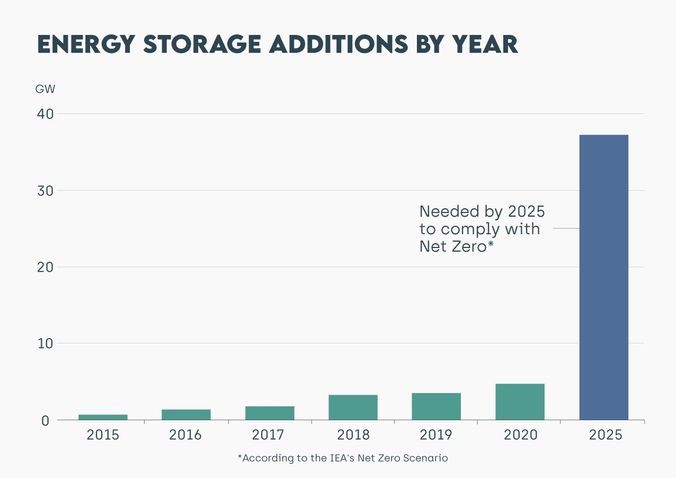
Why this Metric
Fossil fuels pick up the slack when renewables can’t meet demand, either because of bad weather conditions or insufficient capacity. This is why energy storage is a crucial component for a sustainable future, as it counterbalances renewable energy’s intermittent nature.
Battery storage capacity additions hit 5 GW in 2020, up 50% from a “mediocre” 2019 and enough to power 3.75 million homes. Bloomberg NEF predicts that the global energy storage market will grow 20-fold by 2030, hitting the one terawatt-hour mark with China and the U.S. leading the charge.
Still, according to the IEA, it isn’t enough to align with the Net Zero Emissions by 2050 scenario.
Exploring the Metric
Energy storage isn’t just about making up for wind and solar intermittency: it opens a range of solutions for smart grids that can make the overall system more efficient and resilient, regardless of the generation sources. As an example, machine learning could help better predict energy demand patterns and prepare accordingly.
As of today, China, Europe and the U.S. are leading the energy storage market’s rebound after a paltry year in 2019 where new installations failed to rise for the first time in a decade. Total capacity stood at 17GW worldwide by the end of 2020, and overall investment increased by 40% to USD 5.5 billion.
Where the Numbers Come From
Data for our figure was sourced from the IEA’s 2021 Energy Storage report.
Future outlook
National policies will widely dictate the sector’s growth, as new solutions that require broad changes are rarely considered before governmental greenlights and incentives are given. The U.S. and China have been mandating targets for energy storage installation, which is why Bloomberg NEF expects them to claim over half the global installations by 2030.
Other countries making big pushes are India, Australia, Germany, the U.K. and Japan. Regions like the Middle East and Africa lag behind, but we can expect them to catch up as renewables penetrate their markets.
Customer-sited batteries will also grow, responding to a desire to consume self-generated solar power in business and homes. This could be an interesting development, especially if subsidized by local authorities – a U.S. federal study revealed that if Americans installed solar panels on every roof, it would supply 39% of the country’s total electricity.
This article was written by Owen Mulhern. Cover photo by Danilo Alvesd on Unsplash.
Check out our other indices here.










![The Statistics of Biodiversity Loss [2020 WWF Report]](https://u4d2z7k9.rocketcdn.me/wp-content/uploads/2020/12/lprwinkyTHB-544x306.jpg)





